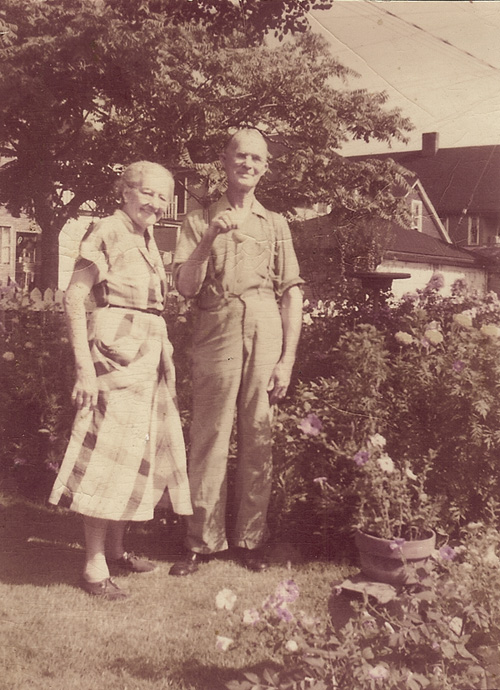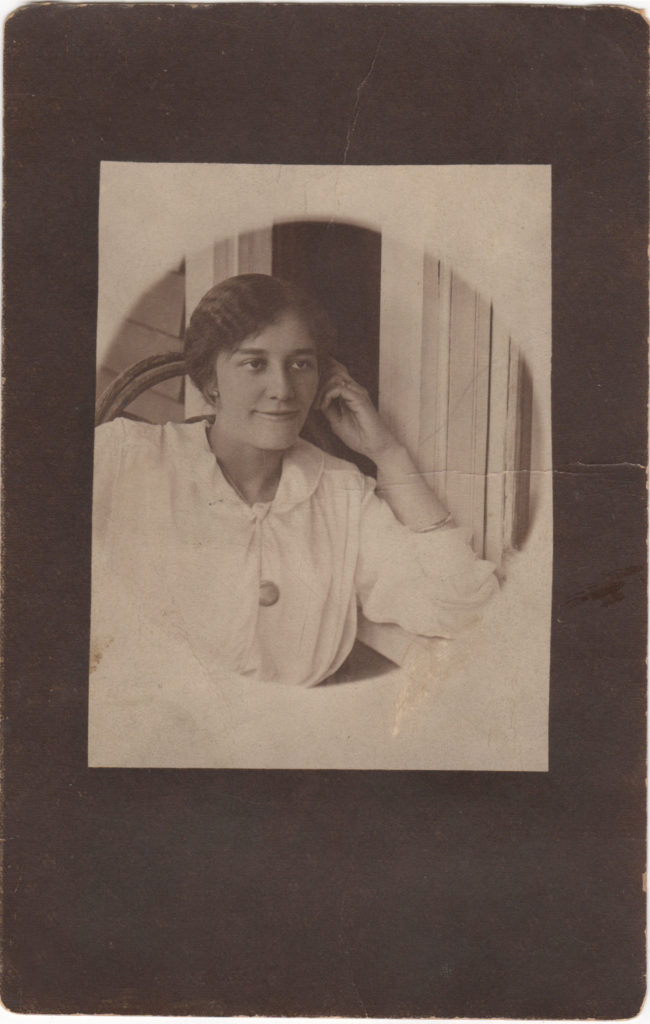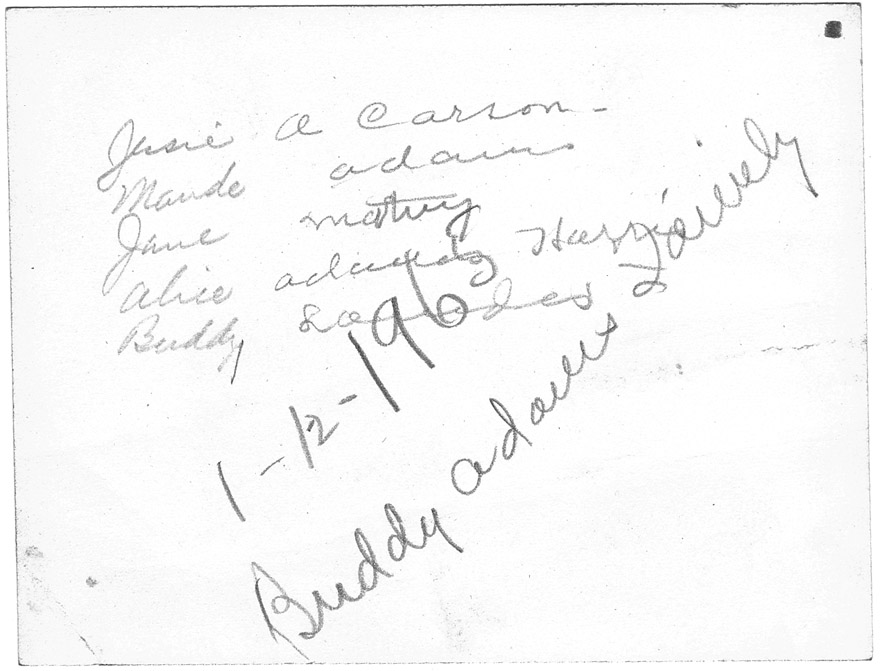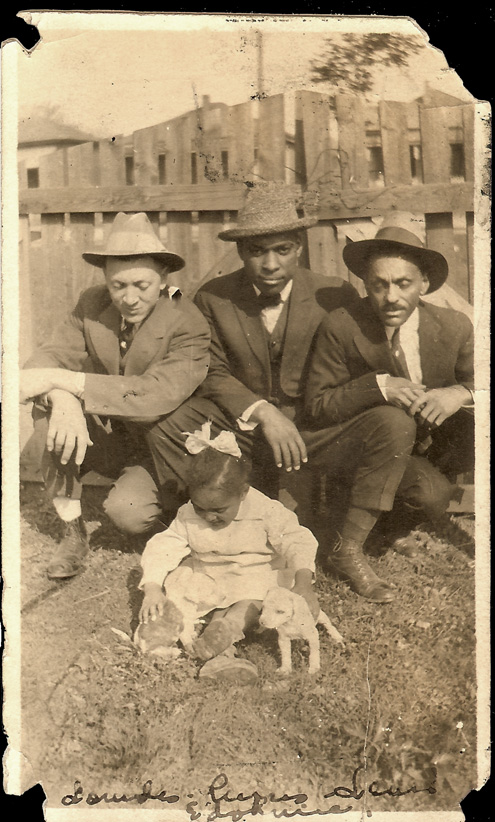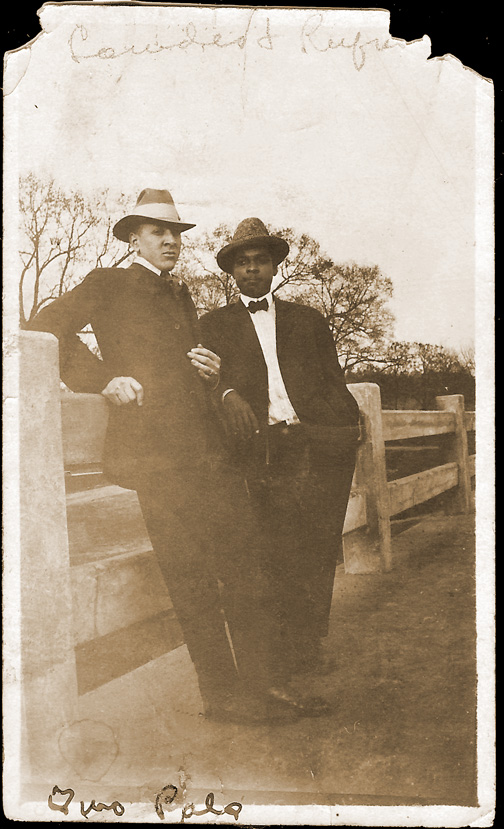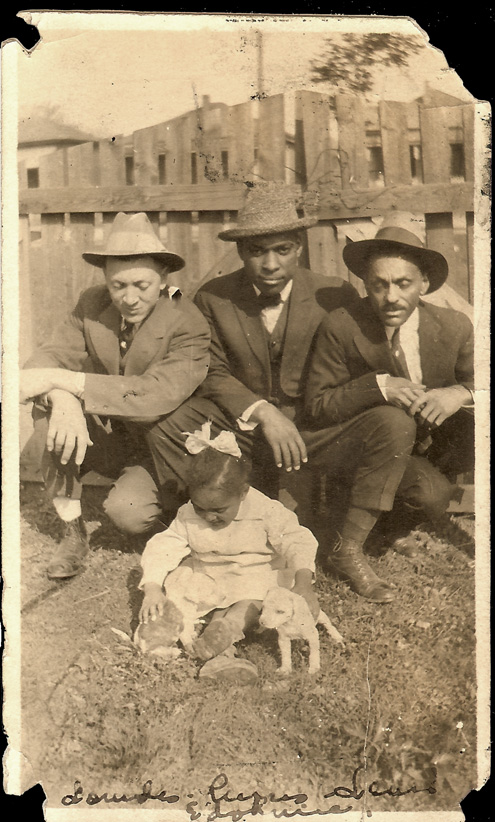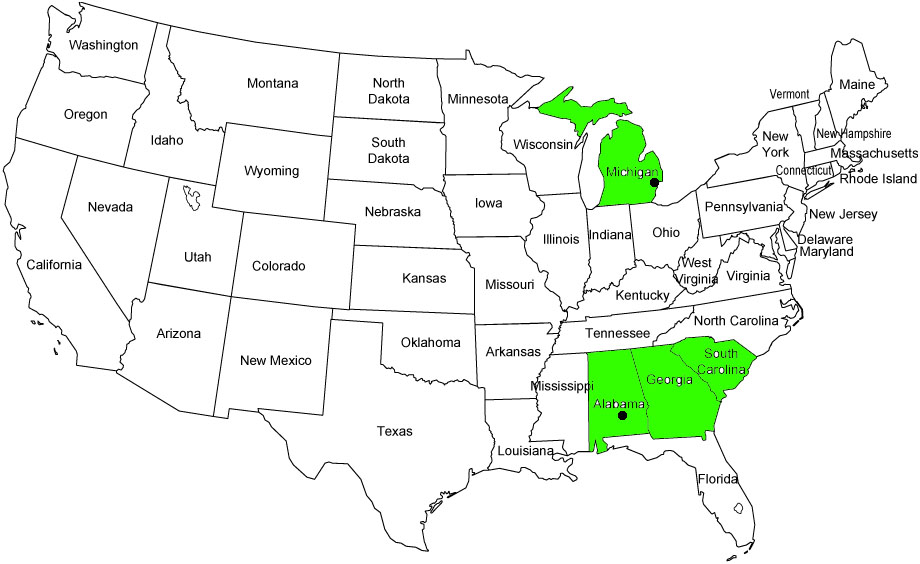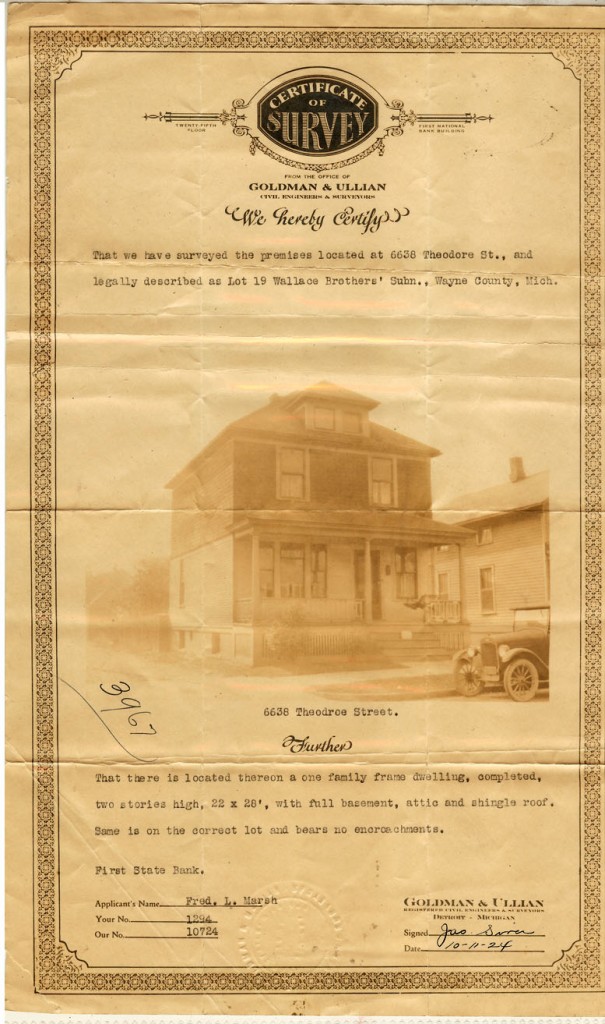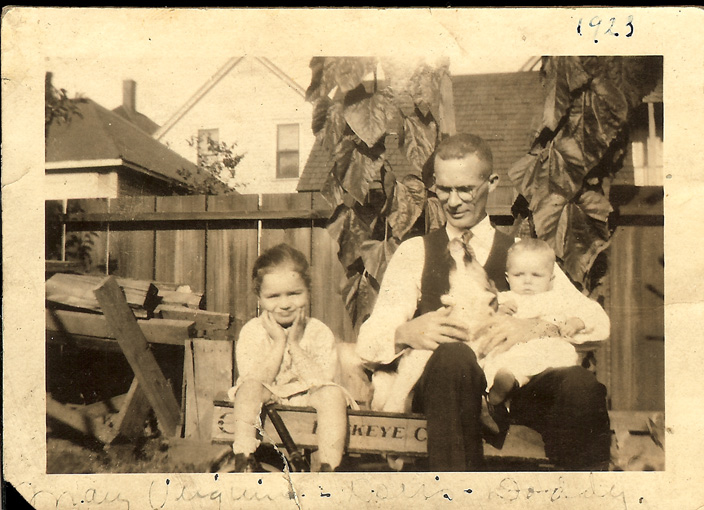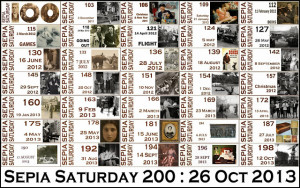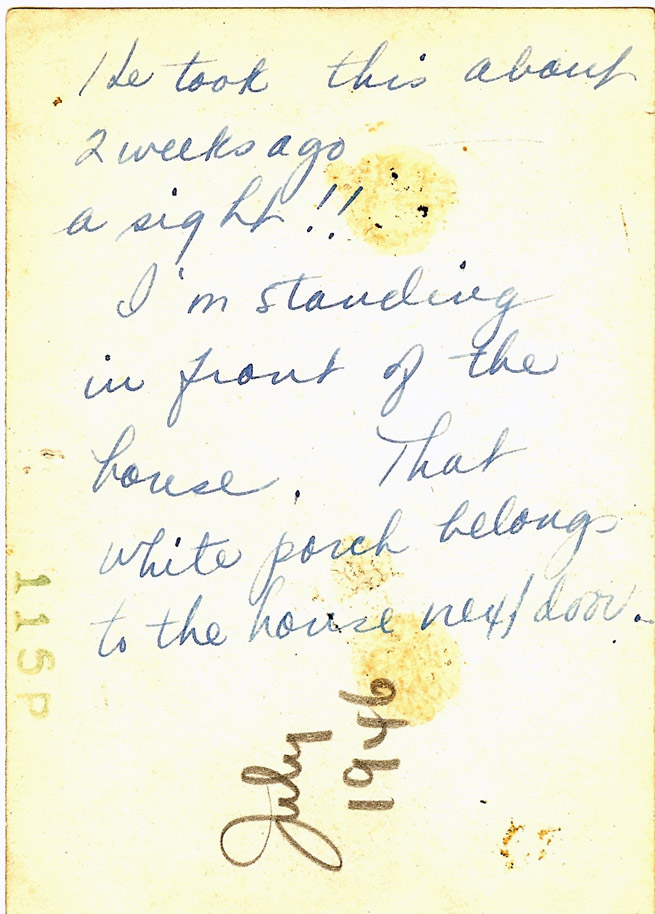 To read more about my mother click Growing Up-In Her Own Words.
To read more about my mother click Growing Up-In Her Own Words.
Category Archives: Grahams
Shell and Fan 1958 and 1941 Sepia Saturday #73
Their backyard was full of flowers, as you can see, with a bird bath in the middle. My grandfather is holding an apple off of the apple tree just off camera to the right. My grandmother made wonderful applesauce with those apples and lots of cinnamon. The vegetable garden was behind the flowers. They were married on June 11, 1919 in Montgomery Alabama and came directly to Detroit. Both were 70 years old in this photo and had been married for 39 years.
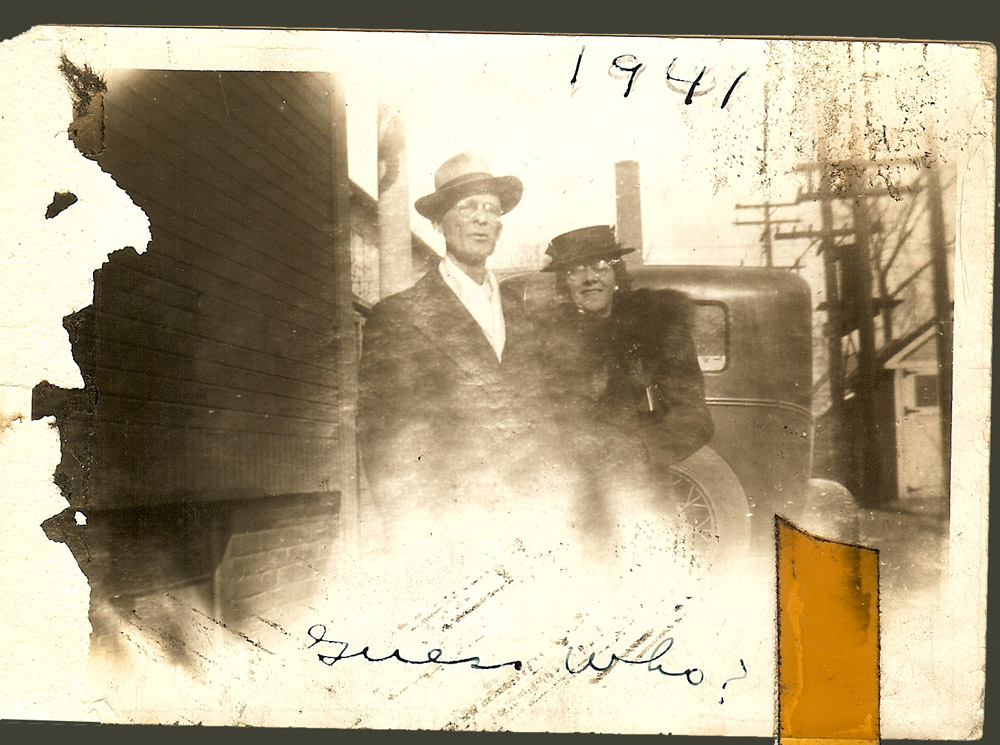 This is one of my favorite photographs of the two of them together. I like the peeling and the white out and even the scotch tape. This one was taken on the side of their house. If we could look in the basement window on the left, we would see my grandfather’s shop which smelled of machine oil and wood and basement and faintly of the pine-sol he sprinkled around. “Lizzie”, the model T Ford is behind them. It was taken 2 February 1941. I bet it was Sunday.
This is one of my favorite photographs of the two of them together. I like the peeling and the white out and even the scotch tape. This one was taken on the side of their house. If we could look in the basement window on the left, we would see my grandfather’s shop which smelled of machine oil and wood and basement and faintly of the pine-sol he sprinkled around. “Lizzie”, the model T Ford is behind them. It was taken 2 February 1941. I bet it was Sunday.
To read my grandfather’s proposal letter to my grandmother, click here. For other Sepia Saturday photographs of older couples and who knows what else this week, click here.
The Proposal
Dear Fan,
I am feeling fine today and I hope that this will find you and all at home well. I am off from my work today. No, not sick just felt like taking a bit of rest and too it has been raining all day and it was such a fine day for sleep before taking my midday nap I had to talk a little to my sweetheart, I only wish I could hear her voice and be made to feel happy. Dear I don’t know anything of interest to write about just now. Things are pretty quiet in Detroit, the factories are all getting ready for a big after war business and I think this city will get her share of it. I am sorry that your mother has been sick, I hope she is O.K. and her self again.
Miss Snow formerly of Montgomery now Mrs. Kelly of Detroit lost her husband last week, I think she will bring the body home for burial. They have him now in storage until she is ready to leave for home with him. Now dear I wrote you sometime ago and told you that I had something to tell you when I saw you, but I just can’t keep it any longer, what I want to tell you dear is this, I feel as if I have tried a single life long enough and now I am going to ask you to become my wife. Now dear, if you will commit to the above request let me know right away and I will write and ask the permission of your mother to marry you, and with her consent we will then fix the time of the wedding. Now I hope you won’t let this shock you any, and please answer me as soon as possible, if we should get married I shall want you to come to this city to live after the wedding, so dear while you are considering the questions of marriage you may also consider the question of residing in Detroit, also.
Now dear please don’t keep me waiting too long for an answer to this letter, as I am over anxious to hear what your answer will be. Remember me kindly to your mother and sisters, with lots of love and many thousand kisses I close, looking to receive an early and favorable reply
I am as ever the same,
Shell
To read Fannie’s acceptance letter click here
Lowndes Adams Found in 1965
Today while looking for old Easter pictures, I found a partial answer to the question I asked at the end of my blog post on the migration from Montgomery to points north – Did Lowndes Adams and my grandfather ever see each other again, or keep in touch? I found a photo from 1965 of Lowndes and four of his sisters. I don’t know where it was taken, not at my grandparents house for sure, but it shows they did keep in touch. From L to R we have: Jessie, Maude, Jane, Alice and Lowndes.
Here is a list of household members in the 1900 census.
James M Adams 53
Ida Adams 41
Sarah Adams 18
Emaline Adams 16
Maud Adams 13
Ida Jessie Adams 12
Lowndes W Adams 9
James Russel Adams 6
Alice Adams 3
Although Jane doesn’t appear in this census, she does appear in the 1910 census as an 8 year old.
More about the migration here:
The Migration From Montgomery to Detroit
Migration Story Part 2
Migration Story Part 3
The Migration Continues Part 4
Now back to looking for those Easter pictures.
Those Left Behind
After reading the letters my grandfather’s friends wrote to him in Detroit from Montgomery, I wondered what happened to those he left behind. Did they stay? Did they leave? I know that my grandparents never returned to Montgomery once they married so I wondered if he ever saw any of them again. I didn’t find them in the photographs in the backyard of the house on Theodore but, if they had moved to Detroit there wouldn’t have been any backyard photos. Those were reserved for out of town guests.
The six young men mentioned were Lowndes Adams, Robert Blakley, Rufus Taylor, Lewis Gilmer, Edgar Speigner and Nathan. I was able to follow them with varying degrees of success. There were twists and turns and connections and dead ends. And always more information to look for and check. Today I decided to write up what I have found so far.
Lowndes William Adams was born February 11, 1893, in Montgomery, Alabama to James and Ida Adams. James was a grocer. Lowndes was the 5th of 7 children. They all were educated and several of his sisters were teachers. Lowndes worked as a stenographer and later was the branch manager of an insurance company. He never married and shared his home with his widowed mother, several sisters, nieces and nephews. He was in Montgomery in 1930. He died in Detroit in 1977. My grandfather died in 1973. I wonder if they had a chance to spend time together.
Lowndes older sister, Emma Lena, married Edgar Speigner before he registered for the WW 1 draft in 1917. Edgar was born September 17, 1882, in Montgomery. He and his brother Charles were raised by their mother, Carrie Taylor who was a cook. Tall and stout, he worked as a pullman porter all of his adult life. Edgar and his wife Emma, raised four children. He died in 1954 in Montgomery, Alabama.
Rufus Taylor was born January 19, 1886 in Montgomery. His parents were Jordan and Fannie Taylor. Rufus was a cousin of Victor Tulane. Victor was married to Eliza and Dock’s daughter, Willie Lee. Rufus lived with the Tulane family for many years and worked in the store first as a clerk and then as a salesman. He remained in Montgomery and married Nan Nesbitt Jones. As far as I know he had no children but helped raise Nan’s son, Albert, from her first marriage. Nan Nesbitt was the niece by marriage of another of Dock and Eliza’s daughter, the youngest, Beulah. That is, Nan was the stepdaughter of Beulah’s husband’s sister. (Are you confused yet?) Rufus died in Montgomery at the age of 51 in 1937.
After posting Migration Story Part 3 last week my cousin, Ruth (who is not related to Nan) asked her cousin (who is related to Nan) if Nan was married to Rufus Taylor, who was Victor Tulane’s cousin and my grandparent’s friend. The answer was, yes, Rufus was Nan’s third of four husbands. After Rufus died, Nan married a Mr. Murphy and ended up in Ohio, where she died in 1988.
I believe Nathan was Nathan Nesbit, a cousin of Nan but have not been able to follow a trail, yet.
Lewis Abram Gilmer was born in Alabama on May 18, 1885. I’m not sure if he was born in Montgomery but he was raised there by his parents Louis and Carnelia Gilmer, along with 7 siblings. His father was a porter, a butler and a chauffeur. Lewis worked as a bank messenger in Montgomery. He and his wife, Annie, had four children. The oldest was born in 1919 in Montgomery. The second was born in1924 in Mississippi and the two youngest were born in 1925 and 1927 in Detroit, Michigan. Lewis worked as a porter at a department store in Detroit. He died there in July, 1969. I tried to find a link between Lewis Gilmer and Ludie Gilmer, who was the son-in-law of Beulah Allen Pope. No luck. Both their wives were named Annie but not the same Annie.
John Wesley Blakley was born January 22, 1893 in Montgomery, Alabama. He married Virgie Dorsette Beckwith, who wanted to leave the south according to John’s letter to Mershell. He was a barber in Atlanta before WW 1 and in Chicago, Illinois afterwards. He and his wife do not seem to have had any children. John was in Chicago in 1942. I have not yet found a death record or census records for 1900, 1910 or 1920 so I do not know his parent’s names or if he had siblings.
Letters from home – Montgomery to Detroit 1917
204 Oak Street
Montgomery, Ala
May 17, 1917
Dear “Shell”:
Really I had begun to say little mean things about you, for it did look like you were going to take as long to write as you did when you first landed in Detroit. You may know what a pleasure it is at all times to receive a letter from a friend and pal.
Well, Cliff and Chisholm are there and how do they like Detroit. Tell Chisholm I know he will conserve a week looking at the skyscrapers and be sure to hold him when he is taken out to the lake. It was a great surprise to know that he left with Cliff, as no one seemed to have been aware of his leaving until several days back. Of course there is no need of advertising your intentions, but he and Cliff both got away without my knowing.
We have been having some real cool weather for this time of the year, and it has caused everything to be unbalanced somewhat.
Yes, I thought strongly of leaving this place on account of the depressing standing of our business and since it has changed for the better, I think I’ll stick a little longer. I thought that my leaving would have been compelling from that point of view.
Edgar is home now, the Pullman Company gave him a run out of here to Mobile so he has transferred here. He told me that he saw you and so many others that he knew and all seem to be getting along fine.
Would you believe me if I say that John Blakey, Lewis Gilmer, Rufus Taylor and myself are the only boys here and we look “motherless.”
Say, I want you to write me if you should see anything that you think may interest me. Have you payed any attention along the typewriter lines; and should you see anything in the papers concerning this particular line of work – send it to me.
Was in Pensacola on April 29 to see my sister. Had a dandy time, and went out to the Navy yard and saw some of our latest methods of war-fare. Tell Chisholm and Cliff to write me sometimes, and my regards to Charlie Anderson and wife in fact, all of my friends that you come across. Now I am expecting to hear from you real soon. With best wishes from us all,
Your chum,
Lowndes
Montgomery Ala Feb 27/1918
My Dear Pal;
Your letter of a few days ago was received, and I can assure you that a line from my old friend was highly appreciated. I remember writing you some time ago and for some reason I did not hear from you until now, but failing to put my address on my letter naturally would leave you in doubt as to where to write me, all of which I am very sorry. I was indeed glad to hear that you and the other boys were all enjoying the very best of health and that the government has used good judgment in classing all of you in class A-1 and I only want you to know that when ever you all get there, you can rest assured that you will have the opportunity of seeing me for I am now in the old city taking my examination, they passed me all OK. So you can see it is very likely I shall soon be somewhere in a training camp, I do wish however that it was possible for me to train somewhere in the Northern camps instead of the southern camps. I am sure you understand why. I shall leave tonight for Atlanta where I shall wait until they are ready for me to report for duty. I was out to see your Mother Monday afternoon. Found her looking and feeling the very best of health and was very glad to see me and to know that I had heard form you. Of course she is worried over the thought of you boys having to go to the army, but said that if there was no way to keep out of it, why she felt she would have to make some sacrifice which is indeed a fine spirit. I also stopped by Gwen and her mother’s. They were both looking fine. She was sick when I was here Xmas so I didn’t get a chance to see her and of course you know I couldn’t leave the city without seeing the Fairest Lady of the land. Glad to say that she is looking just fine said that she would like so much to see you.
Montgomery is as dry as a chip. There is really nothing doing here, all of the boys of our push have gone away with the exception of four Adams, Taylor, Gilmer and Nathan. Mack; I wish it was possible for me to say just at present whether or not I will be able to come west or not this spring or even in the summer but as things are arranged now it is hard for me to say. But if I am not called in to service real soon, why I shall have more time to think it over.
I am doing nicely in Atlanta. I have the 5th chair in a 12 chair shop, which, of course is the largest shop there. So far as getting along OK why I really have no reason to complain, but there is a desire to have that privilege to breath for once in life one deep breath of pure free atmosphere as a man, as well as meeting again with old friends.
I wish to be remembered to Cliff and Chisholm and to you all. I hope your every efforts will be crowned with success.
Trusting that I shall hear from you again real soon,
I am your friend,
J.W. Blakely,
#8 Central Ave.
Atlanta, GA
From Montgomery to Detroit
Dock Allen was born around 1832 into slavery in Georgia. He died free in 1909 in Montgomery Alabama. He was a carpenter. His mother, Matilda Brewster was born in Georgia into slavery. I don’t know when or where she died.
Eliza Williams Allen was born into slavery about 1839 in Alabama. She died free in Montgomery Alabama in 1917. She was a seamstress. Her mother, Anne Williams was born into slavery in South Carolina about 1820 and died free in Montgomery before 1900.
Dock and Eliza’s daughter Jennie Virginia Allen Turner was born in Montgomery, Alabama in 1866. She was a seamstress. She died in 1954 in Detroit, Michigan. In 1887 she married Howard Turner. He was born in Lowndes County Alabama in 1864. He was murdered in Alabama in 1892. His father, Joe Turner, was born into slavery in Alabama about 1839. He was a farmer. He died free in Alabama in 1919. Howard’s mother, Emma Jones, was born into slavery in South Carolina about 1840 and died free in Alabama in 1901.
Jennie and Howard’s daughter, Fannie Turner Graham was born in Lowndes County, AL in 1888. She died in Detroit, Michigan in 1974. She managed a grocery store before her marriage to Mershell C. Graham in 1919. Mershell and both of his parents were born in Alabama. Mershell moved to Detroit, Michigan in 1918. In 1919 he returned to Montgomery to marry Fannie. They both returned to Detroit immediately following the wedding where they roomed with friends from Montgomery for several years. Mershell worked at Fords Motor Co. in the parts section. When they were ready to buy their own house they sent for Fannie’s mother, Jennie and two sisters. All of Fannie and Mershell’s children were born in Detroit. In 1946 Fannie’s Aunt Abbie came up from Montgomery and lived with Mershell and Fannie until her death in 1966.
By the 1960s all of Dock and Eliza’s children and grandchildren had left Montgomery and were living in Detroit, Michigan; Chicago, Illinois; Madison, Wisconsin and New York City. Mershell’s relatives remained in Alabama but contact was lost and we don’t know what happened to them. Joe and Emma’s children stayed in Lowndes County, some moving to Montgomery and Birmingham by the 1930 census. Because my grandmother lost touch with them before leaving Alabama I only know by following the census where they went. I believe some eventually moved to Chicago but I’ll have to wait for the 1940 census to verify.
My cousins and I grew up in Detroit surrounded by family on both sides, who had left Alabama, Kentucky and Tennessee to end up there. Of my grandparents five granddaughters, two remain in Detroit as do their children and grandchildren. One now lives in California where the majority of her children, grandchildren and great grandchildren were born and live. My sister and I, along with most of our children and grandchildren live in Atlanta Georgia.
My mother in Shadow
 This photograph was probably taken about 1937 or 1938 by my father. To see other shadowy family photos look Proof Positive – A Short Story and here.
This photograph was probably taken about 1937 or 1938 by my father. To see other shadowy family photos look Proof Positive – A Short Story and here.
Growing Up – In her Own Words by Doris Graham Cleage
For Sepia Saturday #200, I am re-sharing a piece written by my mother, Doris Graham Cleage, which I first shared in February 2011. I am going to let her tell you about her home life and early years in this piece compiled from some of her writings when she was in her 50s. This is my entry for Jasia’s 103rd Carnival of Genealogy, Women’s History and for Sepia Saturday #63.
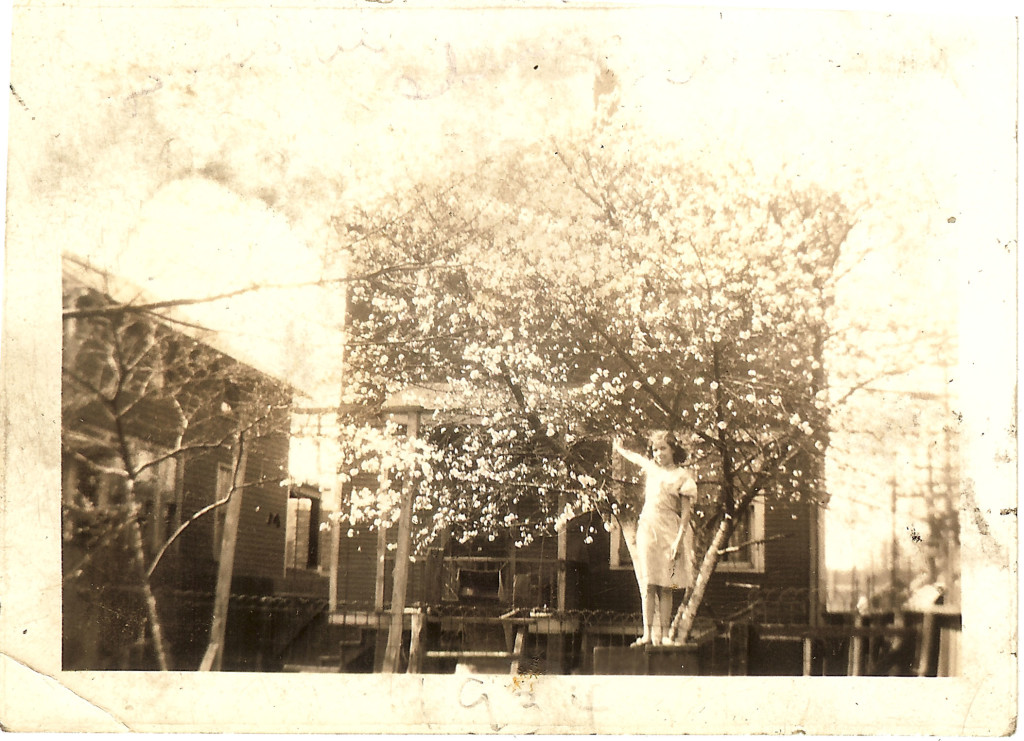
In Her Own Words
My parents married in Montgomery, went to Detroit and roomed with good friends from home, Aunt Jean and Uncle Mose Walker (not really related) A favorite way to pay for your house was to take in roomers from home and it was a good way for them to accumulate a down payment on their own house.
Mary Vee was born in this house. It was a very difficult delivery, labor was several days long. The doctor, whose name was Ames, was a big time black society doctor, who poured too much ether on the gauze over Mother’s face when the time for delivery came. Mother’s face was so badly burned that everyone, including the doctor, thought she would be terribly scared over at least half of it. But she worked with it and prayed over it and all traces of it went away. Mary Vee’s foot was turned inward. I don’t know if this was the fault of the doctor or not, but she wore a brace for years.
Finally that year ended and they bought a flat together with Uncle Cliff and Aunt Gwen (not really related). Mother got pregnant again very soon. Mershell Jr. was born the next year, 1921. I can imagine how she must have felt. She had never kept house, never cooked and never really had someone who told her what to do since she had worked at eighteen. She had never taken care of little children or babies.
Meanwhile I guess Daddy was enjoying being the man of the house, treasurer and trustee at Plymouth, with a good job, a good wife and money accumulating in the bank for a home of his own someday.
Mershell Jr. was born in1921 at Dunbar Hospital, with a different doctor. When he was a year old, I was on the way. The flat was too small. Grandmother Jennie T. was consulted, sold the house in Montgomery and moved to Detroit with daughters Daisy and Alice. She and Daddy and Mother bought the Theodore house together in 1923. I was born in Women’s hospital and came home to that house where I lived for twenty years, until I married. Mother and Daddy lived in it for 45 years.
Grandmother, Daisy and Alice got good jobs, sewing fur coats, clean work and good pay, at Annis Furs (remember it back of Hudson’s?) and soon had money to buy their own house, much farther east, on a “nice” street in a “better ” neighborhood (no factories) on Harding Ave. While they lived with us I remember violent arguments between Alice and I don’t know who – either Grandmother or Daisy or Mother. Certainly not Daddy because when he spoke it was like who (?) in the Bible who said, “When I say go, they goeth. When I say come, they cometh.” Most of the time I remember him in the basement, the backyard or presiding at table. Daisy and Grandmother were what we’d call, talkers.
About four blocks around the corner and down the street from Theodore was a vacant lot where, for some years ,they had a small carnival every year. I don’t remember the carnival at all. I never liked rides anyway. Not even the merry-go-round. But I remember it being evening, dark outside and we were on the way home. I don’t remember who was there except Daddy and I. He was carrying me because I was sleepy so I must have been very small. I remember my head on his shoulder and how it felt. The best pillow in the world. I remember how high up from the sidewalk I seemed to be. I could hardly see the familiar cracks and printings even when the lights from passing cars lighted things, which was fairly often because we were on Warren Ave. I remember feeling that that’s the way things were supposed to be. I hadn’t a worry in the world. I was tired, so I was carried. I was sleepy, so I slept. I must have felt like that most of my childhood because it’s still a surprise to me that life is hard. Seems that should be a temporary condition.
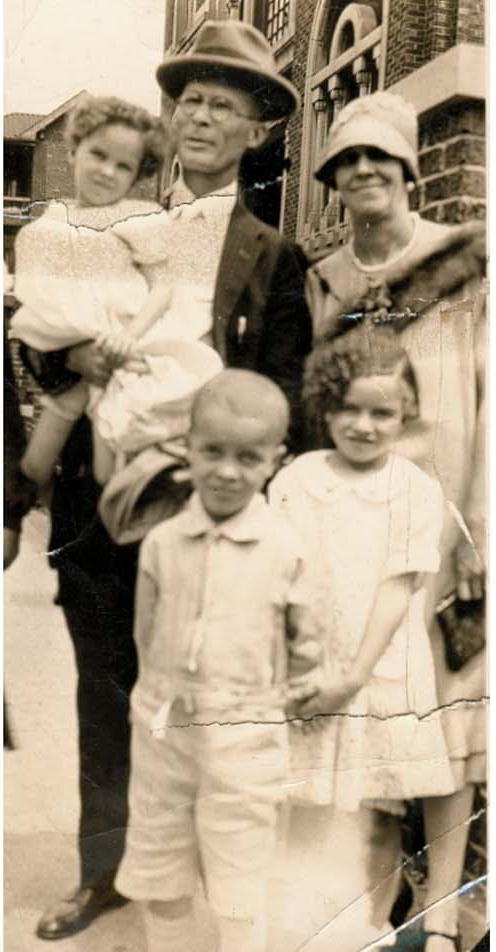
Boy children are very important to some people and my parents were both pleased to have a son. When Mershell Jr. was killed, run over by a truck on his way to school in 1927, it was a great unhappiness for them. I remember standing beside Mother at the front door. A big policeman stood on the front porch and told her about her child. She did not scream, cry or faint. Daddy was at work. She could not reach him. She put on her hat and coat and went to the hospital. I never saw her helpless. She always did what had to be done.
Howard was born the next year. They both rejoiced for here God had sent a son to replace the one they had lost. He died of scarlet fever at three. When you read carefully the things she wrote, you’ll know what this meant to her. But she never took refuge in guilt feelings or hysterics or depressions. She lived everyday as best she could and I never heard her complain.
Ours was a quiet, orderly house. Everything happened on schedule. Everything was planned. There were very few big ups and downs. When Daddy lost his job during the depression and when my brothers died, it was Mother who stayed steady and encouraging and took each day as it came. Daddy would be very depressed and Mother must have been too, but she never let on. I do remember one day when I was about seven and Howard had just died. I came into the kitchen to get a drink of water. She was at the sink peeling potatoes for dinner and tears were running down her cheeks. I don’t remember what I said or did but she said, “I will be alright, but you go and keep your father company.” I did, and I’m sure her saying that and my constant companionship with my father influenced my life profoundly. She was thinking of him in the midst of what was, I think the most unhappy time in her life. How could God send them a second son and then take him, too?
I remember…when I was very young seven or eight – if I got very angry I would go upstairs by myself-take an old school notebook and write, “I will not be angry” over and over until I wasn’t angry anymore. Anger was rarely expressed in our house. I only remember my father and mother arguing twice as long as I lived at home – and I was twenty before I left. But my sister and I fought often. Antagonism was the strongest feeling we had for each other.

Aunt Daisy took us downtown to the show every summer and to Saunders for ice cream afterward. And I always ended up with a splitting headache. Too much high living I guess. She and Alice would buy us dainty, expensive little dresses from Siegel’s or Himelhoch’s. They all went to church every Sunday at Plymouth (Congregational). Daisy always gave us beautiful tins of gorgeous Christmas candy, that white kind filled with gooey black walnut stuff, those gooey raspberry kind and those hard, pink kind with a nut inside, also chocolates, of course!
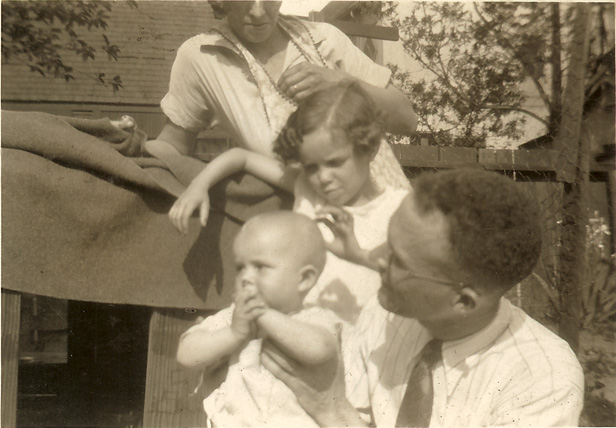
I lived at home until I finished college and married. Everyday when I got home from school the minute I opened the door I knew what we were having for dinner. The house would be full of the good smell of spaghetti or meat loaf or greens or salmon croquettes or pork chops and gravy or steak and onions. We had hot biscuits or muffins every day. My father did not like “store bought” bread. I hardly knew what it tasted like until I married. Our friends were welcome. The house was clean. Our clothes were clean and mended.
Mother often spoke of friends in Montgomery but I never knew her to have a close friend. She was friendly with everyone, especially the Deaconesses with whom she worked at church. She was basically very reserved and what people call today a “very private person”. I don’t remember ever hearing her say “I want” for herself. Oh, she often said, “I want the best for my girls” or “I want you to be good girls” but I never heard her say “I want a new dress… or a day off… or a chocolate bar…” and I never heard her say “I feel this way or that” except sometimes she said, “Oh, I feel so unnecessary.” She was a great one for duty, for doing what was called for and not complaining. You could tell when she was displeased by the expression on her face. Whenever she corrected us, she always explained why, so we came pretty early to know what was expected of us and when we erred the displeased expression was all we needed. She didn’t nag either. No second and third warning. Yet I don’t remember ever being spanked by either parent. If either one said, “Did you hear what I said?”, that did it.
We never talked back to them. We did things we knew we weren’t supposed to do like all children, but we were careful not to get caught. When we did get caught, we were horrified. I never felt confined and resentful, but Mary Vee did.
Mother had some of the same reserve with us that she had with strangers. We rarely talked about feelings, good or bad. She and Daddy tried to keep things as even and calm as possible all the time. So everybody cried alone although you always knew they would do anything for you because they did. You didn’t bring your problems home and share them. You came home and found the strength to deal with those problems. At least I did. If you needed help, you asked for it, but first you did everything you could. I don’t think they ever said no to either of us when we asked for help and that extended to grandchildren too.

